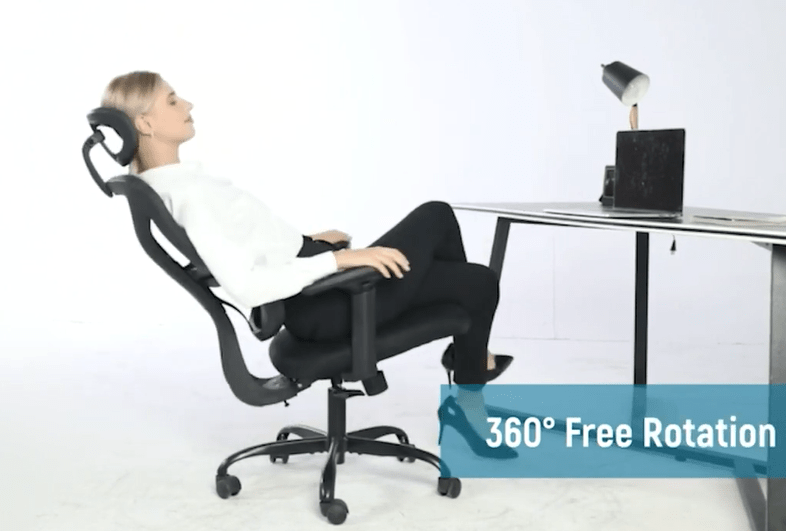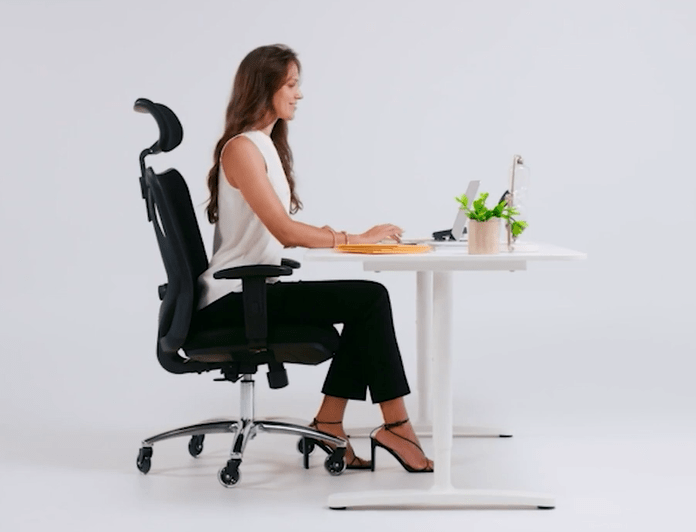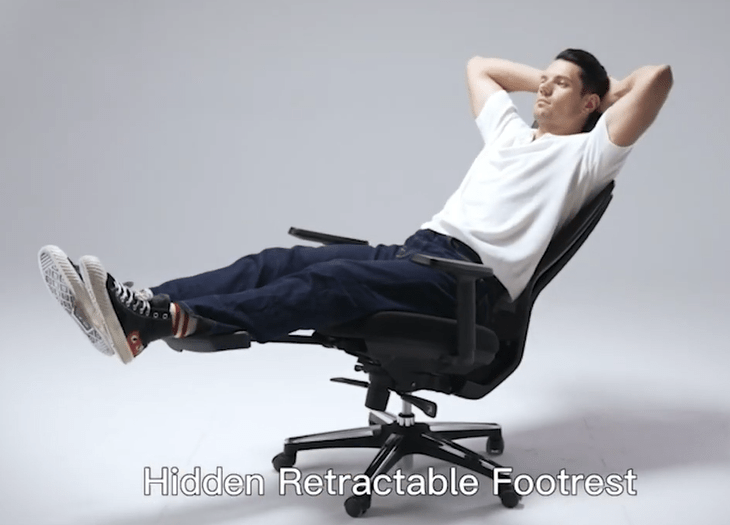Ergonomic office chairs provide optimal support and comfort for a healthy and productive work environment. These chairs are designed to promote proper posture, reduce strain on the body, and prevent musculoskeletal disorders.
By choosing an ergonomic office chair, you can prioritize your physical health and create a more comfortable and efficient workspace. Achieve optimal comfort and support with ergonomic office chairs.
What Makes An Office Chair Ergonomic?
Ergonomic office chairs are designed to provide optimal comfort and support, promoting good posture and reducing the risk of back pain and musculoskeletal disorders. With adjustable features like lumbar support, armrests, and seat depth, these chairs can be customized to suit individual needs and preferences, ensuring a productive and comfortable work environment.
Ergonomic office chairs are designed to provide proper support and comfort, promoting good posture and reducing the risk of musculoskeletal disorders. Here are some key features that make an office chair ergonomic:
| Adjustable Seat Height | Allows users to customize the chair’s height according to their desk or personal preference, ensuring proper alignment of the feet and preventing strain on the legs and back. |
| Lumbar Support | Provides targeted support to the lower back, maintaining the natural curve of the spine and preventing slouching or slumping, which can lead to back pain. |
| Armrests | Height-adjustable armrests help reduce strain on the shoulders and neck, allowing the arms to rest comfortably and supporting proper typing or writing posture. |
| Proper Cushioning | Adequate padding and cushioning on the seat and backrest ensure optimal comfort, reducing pressure points and preventing discomfort during long periods of sitting. |
| Breathable Material | Using breathable fabrics or mesh allows for better air circulation and helps regulate body temperature, preventing sweat accumulation and discomfort. |
Ergonomic office chairs prioritize the well-being and comfort of individuals who spend prolonged hours sitting at a desk. By incorporating these essential features, they provide the necessary support and promote healthier sitting habits, contributing to overall productivity and well-being in the workplace.
Benefits Of Using Ergonomic Office Chairs
Experience optimal comfort and improved posture with ergonomic office chairs. These chairs provide support for the lower back, reduce strain on the neck and shoulders, and promote productivity by ensuring proper alignment of the body.
| Benefits of Using Ergonomic Office Chairs Improved Posture: Ergonomic office chairs are designed to provide proper support to the spine, thus promoting good posture. By maintaining the natural curve of the spine, these chairs prevent slouching and help align the body in a more upright position. Reduced Back and Neck Pain: Sitting in a regular chair for extended periods can lead to back and neck pain. However, ergonomic chairs offer adjustable features that allow individuals to customize their seating position, relieving pressure on the spine and reducing discomfort. Enhanced Comfort: Ergonomic office chairs are made using high-quality materials and cushioning, providing optimal comfort. The adjustable features, such as height, seat depth, and lumbar support, ensure a personalized experience for each user. Increased Productivity: When employees are comfortable and free from pain, their focus and productivity levels increase. Ergonomic office chairs enhance concentration and allow individuals to work more efficiently for longer periods without experiencing the typical discomfort that can distract them. Ergonomic office chairs offer numerous benefits, including improved posture, reduced back and neck pain, enhanced comfort, and increased productivity. Investing in these chairs can significantly improve the overall well-being and performance of individuals in the workplace. |
Adjustability
Ergonomic office chairs offer various adjustable features to provide comfort and support throughout the workday. One important feature is seat height adjustment, which allows users to easily raise or lower the seat to maintain proper alignment with their desk or workspace. This helps prevent strain on the neck and shoulders, promoting better posture and reducing discomfort.
Another crucial aspect of adjustability is the backrest tilt mechanism. This feature enables users to recline the chair and adjust the angle of the backrest to find the most comfortable position for their individual needs. It promotes flexibility and reduces the risk of back pain or fatigue.
Additionally, ergonomic office chairs come with armrest height and width adjustment. This allows users to customize the position of their armrests, ensuring that their arms and shoulders are properly supported, alleviating stress on the upper body.
Lastly, most ergonomic office chairs provide lumbar support adjustment. This feature allows users to adjust the firmness or position of the lumbar support to maintain the natural curve of the lower back, preventing slouching and providing vital support to the spine.
With these adjustable features, ergonomic office chairs offer customizable comfort and support, promoting better posture and reducing the risk of discomfort or pain during long hours of sitting.

Material And Cushioning
Ergonomic office chairs are designed to provide optimal comfort and support for long hours of work. The choice of material and cushioning plays a vital role in enhancing the overall seating experience.
Breathable Mesh Backrest: A popular choice for ergonomic office chairs is a breathable mesh backrest. The mesh material allows for better air circulation, preventing the build-up of heat and sweat, making it ideal for long hours of sitting.
High-quality Foam Cushioning: Another important aspect of ergonomic chairs is the cushioning. High-quality foam cushioning provides excellent support and comfort. The foam adapts to the shape of the body, relieving pressure points and preventing fatigue.
Durable Upholstery Materials: The durability of the upholstery material used in ergonomic chairs is essential for long-lasting performance. Materials such as leather or high-quality fabrics are commonly used, ensuring resistance to wear and tear.
Ergonomic Design Features
| S-shaped Backrest | Waterfall Seat Design | 360-degree Swivel Base | Stable and Adjustable Base |
| Ergonomic office chairs are designed with an S-shaped backrest. This design feature supports the natural curve of the spine, promoting good posture and reducing back strain. | The waterfall seat design promotes healthy blood flow by reducing pressure on the back of the thighs. This helps prevent numbness and discomfort during long periods of sitting. | The 360-degree swivel base allows for easy movement and access to different areas of your workstation without straining or twisting your body. | The stable and adjustable base ensures proper support and comfort. Height adjustment options allow users to find their preferred seating position, aligning their body properly with the desk or workstation. |
Ergonomic Office Chairs Price & Buying Guide
The good news is that you don’t have to break the bank to find a great ergonomic chair in Bangladesh. Prices can vary depending on features, brand, and material quality, but here’s a general idea:
- Online Marketplaces: On platforms like Daraz [Daraz Bangladesh ergonomic chair], you can find ergonomic chairs ranging from budget-friendly options around ৳ 3,500 (Bangladesh Taka) to high-end models exceeding ৳ 50,000. Utilize filters to find chairs within your desired price range.
- Furniture Stores: Showrooms like Teksoi Furniture [Teksoi Furniture ergonomic chair] and Chair Bazar [Chair Bazar Bangladesh ergonomic chair] offer ergonomic chairs at similar price points. Expect chairs to start around ৳ 5,000 and go up depending on features and brand.
Adjusting Seat Height And Depth
Ergonomic office chairs are designed to provide the necessary support and comfort for individuals who spend long hours working at a desk. Adjusting the seat height and depth is crucial to maintaining good posture and preventing strain on the body.
One important factor to consider is ensuring that the feet are flat on the floor. This helps to distribute the body weight evenly and reduces pressure on the lower back. Adjusting the seat height so that the knees are at a 90-degree angle is also essential. This position allows for proper blood circulation and helps to prevent the legs from feeling cramped or numb.
Additionally, it is imperative to ensure that the thighs are parallel to the floor. This helps to promote good posture and reduces the risk of developing musculoskeletal disorders. Proper adjustment of the seat height and depth not only enhances comfort but also improves productivity and overall well-being in the workplace.
Positioning The Backrest And Lumbar Support
Ergonomic office chairs are designed to provide proper support and comfort for individuals who spend long hours at a desk. One important aspect of these chairs is the positioning of the backrest and lumbar support.
The backrest of an ergonomic chair should be adjustable to accommodate different body types and preferences. It should be positioned to provide support for the natural curve of the lower back, also known as the lumbar curve. This helps to maintain good posture and prevent slouching.
Lumbar support is a key feature of ergonomic chairs, as it helps to alleviate lower back strain and reduce the risk of developing back pain. It should be adjustable to suit individual needs and provide adequate support to the lower back.
To avoid slouching or leaning forward while sitting in an ergonomic office chair, it is important to sit back against the backrest and use the lumbar support. This helps to maintain a neutral spine position and distributes the weight evenly across the back. It also helps to reduce pressure on the spinal discs.
| Support for Lower Back Curve | Avoiding Slouching or Leaning Forward |
|---|---|
| – Position the backrest to support the natural curve of the lower back | – Sit back against the backrest |
| – Adjust the lumbar support to provide adequate support to the lower back | – Use the lumbar support |
| – Maintain a neutral spine position | |
| – Distribute the weight evenly across the back | |
| – Reduce pressure on the spinal discs |
Positioning Armrests And Keyboard
Ergonomic office chairs are essential for maintaining proper posture and reducing the risk of musculoskeletal disorders. When positioning armrests and the keyboard, it is crucial to prioritize comfort and ergonomic principles.
For arms to rest comfortably, ensure that the armrests are at the correct height. Adjust them so that your elbows are at a 90-degree angle when your hands are on the keyboard. This will help minimize strain on your shoulders and arms.
In addition, pay attention to wrist alignment. Ensure that your wrists are straight and in line with the keyboard. This will prevent unnecessary stress on the wrists and help prevent issues like carpal tunnel syndrome.
Remember, the proper positioning of armrests and the keyboard is vital for creating a comfortable and ergonomic workspace. By following these guidelines, you can enhance your working experience and support your overall well-being.
Taking Regular Breaks
The importance of taking regular breaks when working on ergonomically designed office chairs cannot be overstated. One of the key aspects of taking these breaks is stretching and relaxing your muscles. When you sit in the same position for extended periods, your muscles can become strained and tense. By taking short breaks every 30 minutes to an hour, you can relieve this tension and prevent long-term damage.
During these breaks, it’s also important to change your posture and position. Slightly adjusting your chair or standing up and walking around can help improve circulation and alleviate any discomfort. Additionally, incorporating simple stretching exercises, such as shoulder rolls or neck rotations, can effectively release muscle tension. Remember, the goal is to find a balance between sitting and movement throughout the day to promote better overall health and well-being.
Incorporating Physical Activity
Regular physical activity is essential for maintaining a healthy lifestyle, particularly for those who spend long hours seated at their desks. Incorporating simple exercises and stretches into your daily routine can help counteract the negative effects of prolonged sitting and improve overall well-being.
One effective way to introduce physical activity into your workday is by taking walking breaks. Set a reminder to get up and walk around every hour or so. Use these breaks to stretch your legs and get your blood flowing. Walking not only helps to reduce the risk of sedentary-related health issues but also boosts creativity and productivity.
During these breaks, try incorporating some quick exercises and stretches to target specific muscle groups. For instance, perform calf raises by standing on your tiptoes and then lowering your heels. Stretch your neck by tilting your head from side to side. These simple movements can help alleviate muscle tension and enhance your overall comfort.
Remember, by incorporating these simple exercises and taking regular walking breaks, you can promote a healthier and more active work environment.
Using Accessories To Enhance Ergonomics
Accessories play a crucial role in enhancing the ergonomics of your office setup. One such accessory is a monitor stand. By elevating your monitor to eye level, it helps maintain proper posture and reduces strain on the neck and shoulders. Additionally, a monitor stand creates more desk space, allowing for a clutter-free work environment.
Another accessory to consider is a footrest. It helps improve blood circulation by providing support to your feet and legs. A footrest also encourages a better sitting position, relieving pressure on the lower back and reducing the risk of developing musculoskeletal disorders.
Lastly, a keyboard tray is a valuable addition to your ergonomic setup. It allows you to position your keyboard at the correct height and distance, ensuring a neutral wrist and arm posture. A keyboard tray also frees up valuable desk space and promotes a more comfortable and efficient typing experience.
Investing in these accessories can greatly enhance the ergonomic benefits of your office chair, promoting better posture, reducing discomfort, and boosting productivity.
Frequently Asked Questions Of Ergonomic Office Chairs
How Do Ergonomic Office Chairs Benefit Your Health?
Ergonomic office chairs provide proper support and posture, reducing the strain on your back, neck, and shoulders. They promote good blood circulation and prevent discomfort and fatigue, increasing productivity and overall well-being.

What Features Should I Look For In An Ergonomic Office Chair?
When choosing an ergonomic office chair, consider adjustable features like height, armrests, and lumbar support. Look for breathable material, a sturdy base, and smooth swivel for ease of movement. Quality cushioning and a contoured shape are also important for optimal comfort.
Can Ergonomic Office Chairs Help Alleviate Back Pain?
Yes, ergonomic office chairs are designed to support the natural curves of your spine, reducing back pain and preventing further injury. The adjustable features allow you to customize the chair to your needs, providing targeted support where you need it most.
How Do I Adjust An Ergonomic Office Chair For Proper Posture?
To achieve proper posture with an ergonomic office chair, adjust the seat height so your feet are flat on the floor. Align the backrest to support the curve of your lower back. Adjust the armrests so your arms are relaxed and parallel to the floor.
Maintain an upright position while working.
Conclusion
To sum up, ergonomic office chairs are key to maintaining comfort and promoting productivity in the workplace. With their adjustable features and supportive design, these chairs prioritize the well-being of employees, alleviating the strain on their bodies and enhancing work performance.
By investing in ergonomic office chairs, businesses can create a healthier and more efficient work environment that benefits both employees and the organization as a whole. Wellness and productivity go hand in hand, making ergonomic chairs an essential component of any modern office space.




